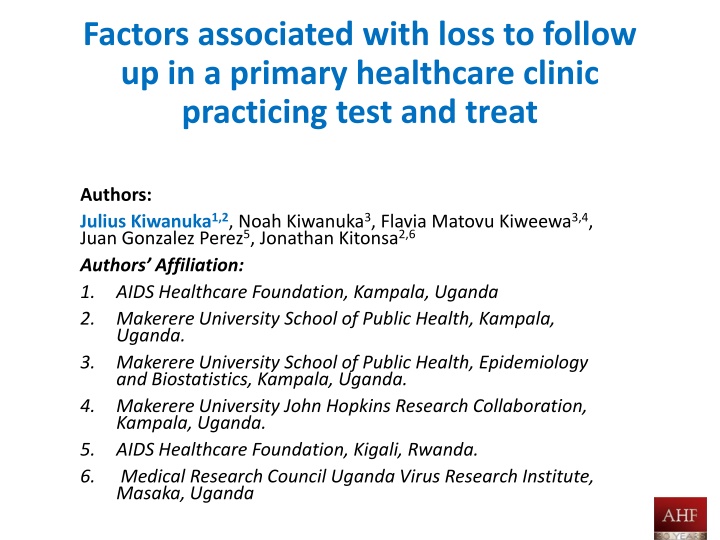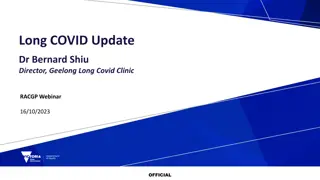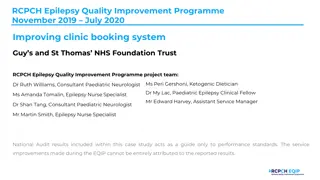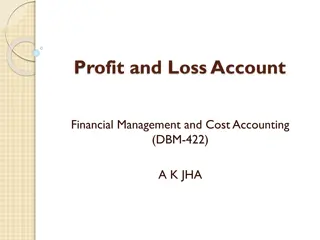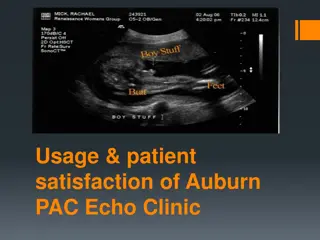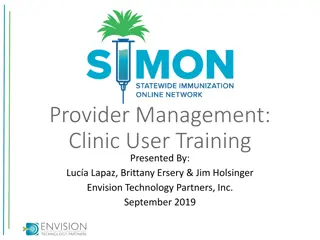Factors Associated with Loss to Follow-up in Primary Healthcare Clinic
This study explores factors related to loss to follow-up in a primary healthcare clinic practicing test and treat, focusing on patients undergoing ART in Uganda. Data was retrospectively sampled and factors were analyzed to determine associations with time to loss to follow-up.
Download Presentation

Please find below an Image/Link to download the presentation.
The content on the website is provided AS IS for your information and personal use only. It may not be sold, licensed, or shared on other websites without obtaining consent from the author.If you encounter any issues during the download, it is possible that the publisher has removed the file from their server.
You are allowed to download the files provided on this website for personal or commercial use, subject to the condition that they are used lawfully. All files are the property of their respective owners.
The content on the website is provided AS IS for your information and personal use only. It may not be sold, licensed, or shared on other websites without obtaining consent from the author.
E N D
Presentation Transcript
Factors associated with loss to follow up in a primary healthcare clinic practicing test and treat Authors: Julius Kiwanuka1,2, Noah Kiwanuka3, Flavia Matovu Kiweewa3,4, Juan Gonzalez Perez5, Jonathan Kitonsa2,6 Authors Affiliation: 1. AIDS Healthcare Foundation, Kampala, Uganda 2. Makerere University School of Public Health, Kampala, Uganda. 3. Makerere University School of Public Health, Epidemiology and Biostatistics, Kampala, Uganda. 4. Makerere University John Hopkins Research Collaboration, Kampala, Uganda. 5. AIDS Healthcare Foundation, Kigali, Rwanda. 6. Medical Research Council Uganda Virus Research Institute, Masaka, Uganda 1
Background and rationale World health organisation recommends T&T in all, regardless of CD4 cell count or WHO stage. (WHO) currently Current HIV treatment programs especially in sub Saharan Africa are plagued with the challenge of patients loss to follow up. To date, little information is available on factors associated with LTFU in a T&T setting. We set out to study factors associated with loss to follow up (LTFU) in a primary healthcare facility practicing T&T. 2
Methods We retrospectively sampled 600 patients from routine patients' data in OpenMRS at Masaka Regional Referral Hospital Uganda Cares clinic. Clinic started piloting T&T at the beginning of 2012. Included patients tested and initiated on ART from January 2012 to December 2014. Defined (T&T as Test date=ART start date; Deferred=Otherwise) Analysis date Dec-2014 We defined loss to follow up as; Failure of the client to show up at the Masaka clinic for at least 90 days from the date of their last scheduled appointment taking 31st December 2014 as the reference date. We determined cumulative incidence of loss to follow up at differing time intervals. Compared LTFU using competing risk regression Used multivariable cox proportional hazards regression model to determine factors associated with time to LTFU (with death as a competing risk). 3
Ethical Considerations Ethical review/approval was sought from the Makerere University School of Public Health Institutional Review Board (MUSPH-IRB). Engaged Clinic s management where the study was conducted. Program data routinely collected and entered into an electronic records management system (OpenMRS) was extracted with patients identifying information only limited to a database Identification Number (patient ID). 4
Results Results Baseline characteristics. Characteristic (s) Started ART instantly Females Median Age (IQR) Median CD4 at Start of ART (IQR) Proportion of patients in WHO stage 3&4 Percent 50% 64.7% 30.4 (23.8-37.1) 373 (204-570) 15.2% Proportion of Patients with Access to Phone Proportion with suspected or diagnosed TB 43.5% 7.5% 5
1 Results.. Results.. .9 Compared to the T&T group (12.3%,95% CI=7.9-17.5%), cumulative incidence of LTFU was 5.9% (95% CI=3.6- 9.0%) in the deferred group within 12 months of ART initiation .6 .8 .7 Cumulative Incidence of Loss to Follow up by mode of Treatment .5 Cumulative incidence of loss to follow-up .4 .3 .2 .1 0 0 6 12 18 24 30 Time in Months T&T Deferred 6
Factors associated with LTFU Factors associated with LTFU 7
Sensitivity Analysis Sensitivity Analysis 1 Compared to the T&S group (13.3%,95% CI=8.8-18.8%), cumulative incidence of LTFU was 5.3% (95% CI=3.1- 8.3%) in the deferred group within 12 months of ART initiation .6 .9 .8 .7 Cumulative Incidence of Loss to follow up by mode of Treatment .5 Cumulative incidence of loss to follow-up .4 .3 .2 .1 0 0 3 6 9 12 15 Time in Months 18 21 24 27 30 T&S Deferred 8
Summary and conclusions Summary and conclusions Summary Initiating on ART instantly (T&T) was associated with an elevated risk of LTFU. Advance disease (WHO stage 3 or 4) as well as TB suspicion were also associated with a higher risk of LTFU. Access to a mobile phone and high baseline CD4 (borderline sign) were protective against LTFU. Conclusion In a bid to achieve the 90-90-90 campaign, steep ART initiation should be backed by intensive pre-initiation and adherence counseling for better long term retention of patients. 9
Acknowledgement Acknowledgement 10
